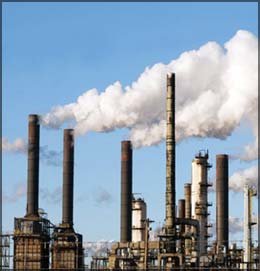|

Lethal air pollution booms in emerging nations
GENEVA-“International experts are warning that potentially lethal
(dangerous) air pollution has boomed in fast-growing big cities in Asia
and South America in recent decades.
While Europe has managed to drastically cut some, but not all, of the
most noxious pollutants over the past 20 years, emerging nations
experienced the opposite trend with their fast economic growth,
scientists at the UN’s meteorological agency said.
Their comments came ahead of World Meteorological Day on March 26 ,
which had the theme “The Air We Breathe”.
The World Health Organisation estimates that about two million people
die prematurely every year as a result of air pollution, while many more
suffer from breathing ailments, heart disease, lung infections and even
cancer.

Fine particles or microscopic dust from coal or wood fires and
unfiltered diesel engines are rated as one of the most lethal forms or
air pollution caused by industry, transport, household heating, cooking
and ageing coal or oil-fired power stations.
In 2005, the WHO estimated that death rates in cities with higher
particle pollution were 15 to 20 per cent above those found in cleaner
cities.
“Particulate matter is of great concern in cities,” said Liisa
Jalkanen, atmospheric environment research chief at the World
Meteorological Organisation,(WHO).
“In Asia many cities such as Karachi, New Delhi, Kathmandu, Dacca,
Shanghai, Beijing, and Mumbai exceed all the limits.” “Also several
cities in South America such as Lima, Santiago and Bogota. The worst
city in Africa is Cairo,” she told journalists.Half of the world’s
population now live in urban areas, and the proportion is expected to
grow to two-thirds by 2030, according to the United Nations.The WMO says
more resources are needed for a global air monitoring network it runs
with national weather offices.
Len Barrie, director of WMO research, said restrictions set up in
Europe after concern about acid rain emerged in the 1980s have cut
concentrations of another pollutant, sulphur dioxide, there “by a factor
of 20”.
“In other areas where economic growth has leapt forward, such as
Asia, China, India, the opposite is true,” he added. In North America
levels were largely kept in check.
But Barrie told AFP that such pollution in China appeared to be
reaching its peak.
“There?s a real awakening in China on the economic benefits of
reducing air pollution,” he added.
Attempts are being made to bring developing and emerging nations, as
well as the United States, into a new global warming pact in Copenhagen
in December.
While such curbs on carbon emissions can have a substantial impact on
overall air pollution, they may not tackle it completely. Levels of
another harmful pollutant, nitrogen dioxide, from vehicle traffic have
not decreased in Europe by as much as the WMO expected, while the impact
of weather patterns on pollution is also a concern.
- AFP
Alaska’s Mount Redoubt volcano erupts
WILLOW, Alaska - Alaska’s Mount Redoubt volcano erupted six times on
March 23, sending an ash plume more than nine miles into the air in the
volcano’s first emissions in nearly 20 years.
Residents in the state’s largest city were spared from falling ash,
though fine gray dust fell Monday morning on small communities north of
Anchorage.
Ash from Alaska’s volcanos is like a rock fragment with jagged edges
and has been used as an industrial abrasive. It can injure skin, eyes
and breathing passages.
The young, the elderly and people with respiratory problems are
especially susceptible to ash-related health problems. Ash can also
cause damage engines in planes, cars and other vehicles.
The first eruption, in a sparsely populated area across Cook Inlet
from the Kenai Peninsula, occurred at 10:38 p.m. Sunday (March 22). The
sixth happened at 7:41 p.m. Monday, according to the Alaska Volcano
Observatory.
There were reports of a quarter-inch of ash in Trapper Creek and up
to a half-inch at a lakeside lodge near Skwentna.
Dave Stricklan, a hydrometeorogical technician with the National
Weather Service, expected very fine ash.
There’s going to be a very fine amount of it that’s going to be
suspended in the atmosphere for quite some time,” he said. “The finer
ash is going to travel farther, and any ash can affect aviation safety.”
The 10,200-foot Redoubt Volcano, roughly 100 miles southwest of
Anchorage, last erupted during a four-month period from 1989-90.
In its last eruption, Redoubt sent ash 150 miles away into the path
of a KLM jet and its four engines flamed out. The jet dropped more than
two miles before the crew was able to The volcano became restless
earlier this year. The observatory had warned in late January that an
eruption could occur at any time.
Three seismometers on the mountain were damaged in the eruption but
seven others remained in place, said observatory geophysicist John
Power.
-AP |

